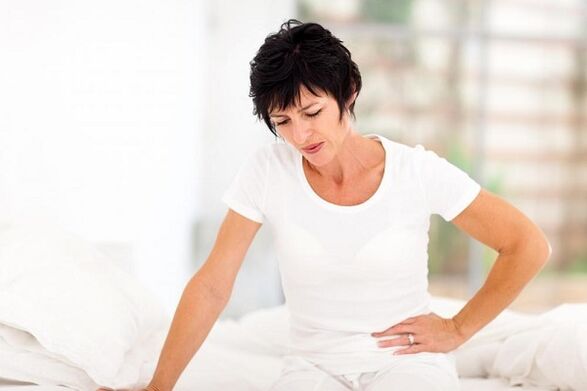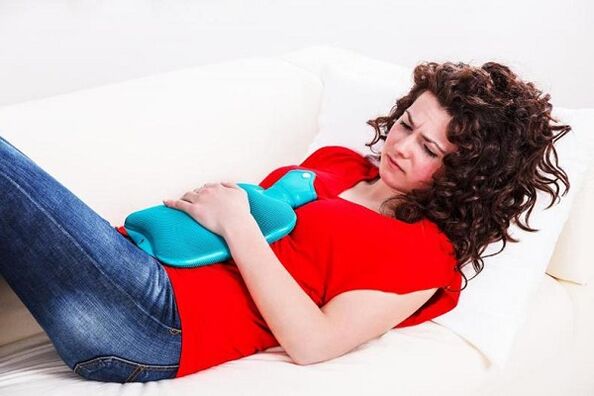Bladder inflammation has an infectious nature and causes various unpleasant symptoms, including distinguishing the pain of stretching over the pubis, frequent but unproductive urination, and blood impurities in the urine. The bladder in women needs more frequent emptying than in men. The organ is vulnerable to attacks of viruses and bacteria. Clinical manifestations in each person may differ, depends on several factors: process location, pathogen, disease nature, gravity. What leads to the appearance of cystitis, how it manifests itself, what threatens and how to fight correctly?
Causes of cystitis in women

Most of the time, the cause of the disease is microorganisms, which are the natural inhabitants of our body, for example, this applies to E. coli. Conditionally pathogenic microflora is under the control of immunity, which controls growth and the number of microorganisms. If, under the influence of certain factors on the operation of the immune system, a flaw occurs, conditionally pathogenic flora may be out of control and lead to an inflammatory reaction.
Women are vulnerable to cysts for these reasons:
- Location near the vagina and anus;
- The urethra is wide and short.
There are several ways to penetrate the pathogens in the bladder cavity:
- Ascending. The infection penetrated the urethra;
- Descendant. Microorganisms penetrated the kidneys;
- lymphogenous. Pathogens spread from the pelvic organs;
- Hematogenic. This method is quite rare. This means that the infection came with a blood flow of some organ.
Although most of the time cystitis appears against the background of other diseases, in some cases the disease may develop in the form of an isolated process. The reason for this may be the following factors:
- violation of the rules of intimate hygiene;
- chronic constipation;
- Avitaminosis;
- with a child and work;
- Surgical intervention in urinary organs;
- colds, hypothermia, sitting on the cold surface;
- Errors in nutrition, in particular, abuse of salty foods;
- the randomness of sexual activity, a frequent change of partners;
- kidney diseases;
- hormonal imbalance;
- diseases that contribute to the weakening of immunity;
- wound;
- Wearing compressive synthetic underwear.
More often, cystitis is a complication of such diseases:
- bacterial vaginosis;
- vaginitis of candidiasis;
- Sexual diseases: gonorrhea, chlamydia, ureaplasmosis, mycoplasmosis.
Sometimes even taking medications, in particular, cytostatics, causes inflammation of the bladder mucous membrane. Sometimes even an allergic reaction can serve as an inflammation trigger mechanism.
The first signs of cystitis in women
At the beginning of the disease, the first sign of cystitis in women is a change in urine color. It acquires a specific smell and is cloudy. The calls for urination are also becoming more frequent. The urination process is accompanied by unpleasant sensations: discomfort or burning. The temperature may rise, but this is not a mandatory signal.
One way or another, in the first signs of cystitis, a woman needs to worry and get involved in treating the disease.

Types of cystitis in women
Depending on the nature of the course of inflammation, the disease can be of two types:
- acute cystitis;
- Chronic cystitis.
Cystitis differs in the emergence of morphological changes:
- Qatarhal;
- ulcerative;
- cystic;
- Hemorrhagic;
- ulcerative and others.
Depending on the etiological factor, the disease is bacterial, viral, fungal and not bacterial. The following bacteria can cause the appearance of cystitis:
- E. coli;
- gonorrhea;
- ureauplasma;
- mycobacteria;
- Staphylococcus or Streptococcus;
- Mycoplasma.
No bacterial cystitis, in turn, is divided into:
- allergic;
- medicine;
- chemical;
- ray;
- toxic.
Cystitis symptoms in women
Most of the time, cystitis in women begins sharply and suddenly with the appearance of such signs:
- frequent desire for urination;
- pain, rubber, burning;
- involuntary urinary incontinence;
- the desire to empty the bladder at night;
- During urination, the woman makes a lot of effort and pushes;
- Pain occurs in the area of pubis and perineum. Sometimes they acquire an unbearable cut of nature;
- hyperthermia;
- deterioration of the general well -Ser, weakness;
- Urine acquires a muddy color of purulent nature;
- Hematuria.
Complications of Cystitis in Women
Cystitis complications include:
- Hematuria. In some cases, bleeding can develop;
- Interstitial cystitis. The bladder is wrinkled, reduced in size and its functional activity is seriously violated;
- Pyelonephritis. The spread of the infectious process along the ascending paths can threaten the appearance of inflammatory reactions of the kidney structures.
Blood cystitis in women
Usually the urine has a light yellow color. Hematuria can cause a decrease in bladder muscle tissue tone, a violation of blood circulation or the inability to empty the bladder for a long period of time. According to statistics, cystitis in 60% of cases comes in a chronic form. The main mistake is to tighten! The sooner the treatment of cystitis begins, the better.
The presence of hematuria may indicate the development of forms of cystitis that represent a threat to the patient's life:
- Hemorrhagic. The walls of the blood vessels are affected, they become brittle. Most of the time, it occurs with the introduction of adenovirus or fungus, as well as in the form of a complication of radiation disease;
- Gangrenous. In fact, bladder tissue dies. Gangrenous cystitis is dangerous for the development of blood poisoning. The reason for this condition may be some drugs or the presence of a foreign body;
- Ulcerative. Associated with the radial effect on the tumor process. Often there is abundant bleeding that threaten death.
Blood cystitis is accompanied by the appearance of such symptoms:
- false urination;
- The pain becomes so unbearable that a woman takes painkillers;
- Fighting pain in the lower abdomen is deprived of sleep and rest;
- an accentuated increase in temperature;
- Spontaneous urination.

There are several types of hematuria:
- Micromaturia. Blood discharge is insignificant. Patients may not even notice that, but blood is detected on a laboratory test. Most of the time, microgematuria indicates at the beginning of the inflammatory process or the exacerbation of chronic cystitis. Sometimes the symptom indicates the presence of lesions in the genitourinary sphere;
- Macrohematuria. Bleeding becomes abundant by nature, which cannot be noticed. Urine becomes scarlet.
In any case, the appearance of blood in the urine is a symptom that indicates the presence of a serious violation, so it is extremely important to consult a specialist. Hematuria is dangerous for the occurrence of such complications:
- transmission of other types of infection;
- Violation of microflora balance;
- the development of urinary system diseases, in particular, urethritis;
- Blood clots can clog the urinary channels, making urine highlighting -a;
- Stretching and damage to the bladder walls;
- urine incontinence;
- Process chronization.
Diagnosis of cystitis in women
The diagnosis is based on clinical and laboratory data, as well as ecoscopy and endoscopy. The supranel region's palpator examination is extremely painful.
In the overall analysis of the urine, there was a greater content of red blood cells and leukocytes, there are proteins, mucus, bacteria. The bacteriological sowing of urine is characterized by the abundant growth of pathogens.
Be sure to drive a bladder ultrasound. Cystoscopy allows you to identify the morphological form of organs damage, as well as identify calculations. Foreign bodies and neoplasms.
Cystitis Treatment in Women
Cystitis requires an integrated approach to your treatment. When taking pills, unpleasant symptoms can spend a few days, but the infection can hide and at the right time "show your teeth".
Taking cystitis pills should be combined with food nutrition. The essence of the diet is to create gentle conditions for the patient. Do not irritate the inflamed mucosa membrane of the bladder of acute, salty and canning food and especially alcohol.
But drinking liquid should be as much as possible. Thus, you contribute to the excretion of pathogenic microflora and make a urine, which will be less irritated with the inflamed organ.
The basic principles of cystitis treatment in women include the following:
- the struggle against the infectious process;
- relief of an inflammatory reaction;
- Pain removal;
- Strengthen immunity;
- Sparning diet and abundant drink.
Cystitis Medicines in Women
You can forget cystitis using these medicines groups:
- anti-bacterial;
- antispasmodic;
- Probiotics;
- anti -non -esteroids inflammatory;
- PHYTOPREPARATIONS.
Antibiotics
The doctor is involved in selecting the antibiotic after receiving data from urine bacteriological sowing and identifying drug sensitivity. It is important to undergo an antibiotic therapy to the end, otherwise the disease can be repeated after a while.
Phytoprepactions

It is difficult to overestimate the healing effect of medicinal herbs. If previous women collected, dried and insisted on herbs, then, in our time, there is no urgent need for this, because the ready -made preparations are sold in pharmacies.
Phytotherapy is not mono, but is used in combination with antimicrobials. They increase the therapeutic effect of antibiotics and also reduce the risk of adverse reactions.
Household treatment
Sometimes a visit to the doctor is not possible in the near future. These are exceptional cases in all other cases, when the first symptoms appear, it is important to consult a specialist.
At home, you can cure cystitis lightly as long as the disease is not accompanied by pain and hematuria. But even in this case, it is important to undergo an exam and consult a urologist.
It is extremely important for women to observe rest in bed. The female body should not be overwork, must have the strength to combat the disease.
Folkloric treatment
Non -traditional recipes allow cure cystitis without damage to your health. They are used as an addition to the main drug therapy and are used with the consent of the doctor. Among the folkloric recipes of cystitis in women are the most common:
- Baths sitting. As a base, you can take pharmacy chamomile flowers. The plant has anti -inflammatory properties, which will help relieve symptoms of the disease. The plant is spilled with boiling water and left to prepare. After the decoction is filtered, it is added to the basin with water. After the procedure, you must involve and lie down;
- cranberry. Cranberry juice will help eliminate the first symptoms of cystitis, but this is subject to the primary manifestations of a poorly expressed disease;
- Medicinal herbs decoctions. The collection can be bought with a pharmacy or independently prepared from such ingredients: echinacea, mint, St. John's grass, corn stigmas, pine shops, bear edge, linen seeds, chamomile, field field, eucalyptus. Such a collection has an antimicrobial and anti -inflammatory effect.
Prevention of Cystitis in Women
Simple recommendations below will help avoid the appearance of the disease:
- Ideally, there must be a sexual partner. In case of random connections, condoms must be used;
- Compliance with hygiene rules. It is best to use soap with a neutral acid base balance;
- Emphasize the bladder in a timely manner, do not tolerate;
- Try no hypothermia, seen over time, do not feel in the cold;
- Drink natural water in sufficient quantities;
- Do not wear very tight clothes. Things are laundry for special occasions, but not for daily use;
- Follow your diet, do not allow constipation. Eat foods containing fiber, bacteria of lactic acid. Kurag, plums, fresh cabbage have a laxative effect.
Conclusion
Cystitis in women is an infectious and severe inflammatory disease that offers great discomfort. The disease worsens the quality of life and hurts. Cystitis threatens the occurrence of serious complications, sometimes even represents a danger to the patient's life. An unexplored disease leads to the spread of the infectious process and the transition from pathology to a chronic form.
The diagnosis is the first stage of the therapeutic process for cystitis in women. Self-diagnosis can lead to a false path, which is why you will waste precious time. Cystitis treatment is involved in a urologist. Includes drug therapy, folk treatment and food nutrition. Follow all medical recommendations, don't forget to prevent and be healthy!
























